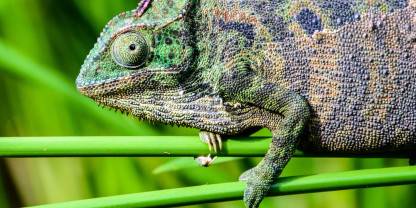Average Expert Rating
Rating Breakdown
Write a User ReviewExceptional Biodiversity in Ranomafana National Park
The early morning view from my humble room on the main road running through the park was mesmerizing. Rainforest clad slopes shrouded in mist stretched out in every direction. This nearly impenetrable jungle is known for its exceptional biodiversity but from where I was standing, I couldn’t imagine finding anything as small as a lemur in there. The needle in a haystack analogy came to mind. However, Bertrant, my guide for the day, seemed in good spirits when we set out on the 15km/9mi Circuit Varibolomena known for its lemur-viewing opportunities. We saw a small group of red-bellied lemurs and a solitary mall-toothed sportive lemur sitting in the fork of a tree looking down at us with its big round eyes. We did well on the reptiles too; we saw a large panther chameleon and the true master of camouflage, a leaf-tailed gecko. Most exciting was a glimpse of a fanaloka crossing the forest path in front of us. Bertrant assured us that seeing this small secretive nocturnal predator was quite
Read more
a treat as night walks were no longer allowed in the park and it was very rare to see these shy creatures during the day. Getting back to our starting point, I noticed Bertrant checking out some roadside plants. Five minutes later, he came back with a big grin on his face, happy to be able to show us one more animal before we left, the endemic giraffe-necked weevil. These bizarre looking bugs have elongated necks with which males fight off their opponents during the mating season. Speaking of a needle in a haystack…Bertrant and the other guides will find it for you!Top Lemur Viewing and Hiking
Among the most biodiverse of Madagascar’s protected areas, Ranomafana is also one of the most popular thanks to its ready accessibility from the RN7/25 as it runs south of Antananarivo. It protects an area of chilly highland forest that supports 12 species and can be explored along several guided trails. On a day hike out of the main Varibolo ticket office, we had excellent views of the beautiful golden bamboo lemur, a Critically Endangered species first discovered in 1986, as well as red-fronted brown lemur and red-bellied lemur. Other lemurs that are active during the day that we saw more distantly or missed include Milne-Edward’s sifaka and black-and-white ruffed lemur, while of five nocturnal species, we had a good sighting of the cute little rufous mouse lemur. A checklist of 115 bird species includes numerous forest-associated endemics and we found it rewarding to spend a couple of hours birding unguided along the main road, which offers cleaner views into the canopy than the

